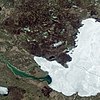Slika:Great Slave Lake, Landsat 8 2015 (cropped).jpg

Velikost tega predogleda: 634 × 599 točk. Druge ločljivosti: 254 × 240 točk | 508 × 480 točk | 812 × 768 točk | 1.083 × 1.024 točk | 2.166 × 2.048 točk | 5.904 × 5.582 točk.
Izvorna datoteka (5.904 × 5.582 točk, velikost datoteke: 8,61 MB, MIME-vrsta: image/jpeg)
Zgodovina datoteke
Kliknite datum in čas za ogled datoteke, ki je bila takrat naložena.
| Datum in čas | Sličica | Velikost | Uporabnik | Komentar | |
|---|---|---|---|---|---|
| trenutno | 02:36, 26. april 2022 |  | 5.904 × 5.582 (8,61 MB) | Hubert Kororo | File:Great Slave Lake, Landsat 8 2015.jpg cropped 34 % horizontally, 38 % vertically using CropTool with lossless mode, better crop |
| 01:19, 26. april 2022 |  | 6.421 × 5.600 (5,85 MB) | Hubert Kororo | File:Great Slave Lake, Landsat 8 2015.jpg cropped 29 % horizontally, 38 % vertically using CropTool with lossless mode. |
Uporaba datoteke
Datoteka je del naslednje 1 strani slovenske Wikipedije (strani drugih projektov niso navedene):
Globalna uporaba datoteke
To datoteko uporabljajo tudi naslednji vikiji:
- Uporaba na cs.wikipedia.org




